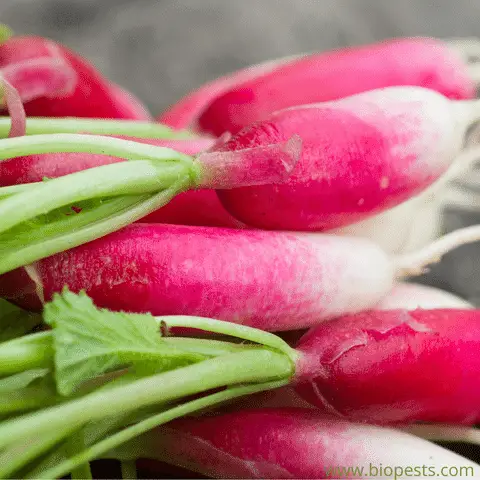Radishes are crunchy with a sweet and peppery taste, and thinly sliced radish is delicious in salads and sandwiches. This cute vegetable is a quick and easy grower, but some pests like to eat them too. So why do radishes get worms, and what are the tips on how to solve this problem?
Radishes are attacked by different worms that eat their roots and leaves. This is caused by poor soil drainage, the presence of weeds, and planting when the soil is too cold. There are methods to control worms, like spreading alkaline mulch around the radish plants.
Read on for more about the different worms that attack the radish plant and how to get rid of these pests.
Radishes And Worm Pests
Radishes are for growing during the cooler season. These delicious spicy, crisp, and zesty-tasting vegetables grow in abundance. But they do have nasty pests that like to eat them!
Why Do Radishes Get Worms?
Radishes are speedy growers, so they are not in the ground for too long for pest populations to cause significant issues. However, they do have a problem with worms. If the roots are damaged, it is likely to be maggots.
To prevent worms from attacking your radishes in the future, use the guide below.
- Before planting radishes, ensure good drainage in the planting area. It is essential to rotate crops and avoid growing the same vegetables where there have already been problems with worms.
- Plant seedlings when the soil is warm, even if it means planting a bit later in the season. Planting later could benefit the radishes as the seeds will germinate quicker, and the plants will establish sooner. This reduces the time the radish plants are in the early stages of growth when worms cause the most damage.
- Always control weeds in the area where you are growing radishes. Also, consider not growing crops for the summer season in the area where worms have been a problem. At the same time, still, control weeds in this area.
- Spread an alkaline mulch around the radish plants. This will discourage egg-laying.
Types Of Worms That Damage Radishes
Below are some of the worms that can cause damage to your radishes and how to solve the problem.
Cutworms Eat Radishes
Cutworms are the larvae, in caterpillar form, of night-flying moths. The moths do no harm, but their larvae eat the radish stems right at the bottom near the ground. These larvae come in different colors according to their species. Some are black, brown, gray, tan, green, or pink. Others have stripes or spots and are the color of the soil.
These worms grow to about 2 inches in length, and when picked up, they curl into a C-shape. These worms hide during the day and come out to feed and do their damage at night. Some might also climb up the radish plant to do damage higher up.
How To Solve The Problem of Cutworms In Radishes?
To determine the extent of the infestation of cutworms, dig into the soil. The larvae hide under the soil during the day but are active feeders at night. These cutworms cause extensive damage in a short period, so it is best to inspect plant beds frequently.
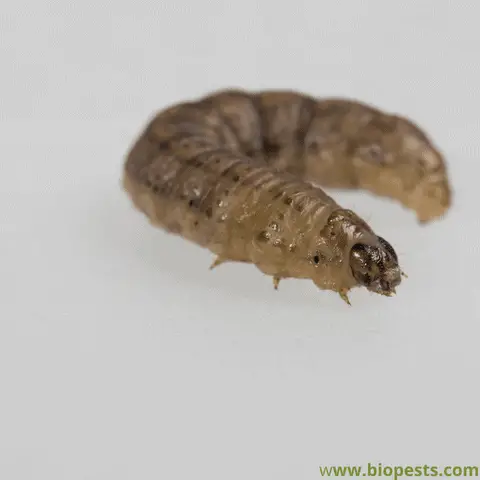
You could try harrowing between rows of seedlings where the cutworms are feeding. If this does not contain them, chemical control is required. Below are some materials that can be used. Apply one of the following to the soil where there is a sign of cutworm activity.
- Neem oil
- Carbaryl – where cutworms are on the surface, a carbaryl drench may help but ensure that there is no bee activity.
- Deltamethrin – natural insecticide from chrysanthemum flower
- Insecticidal soap, organic – this may require more than one application
- Plant-derived essential oils – rosemary or peppermint.
- Kaolin – a spray that is applied to the foliage. For more information on kaolin, read here.
Cabbage Loopers Destroy Radish
These green and fat caterpillar-like worms are called Cabbage Loopers because of the wobbly and looping way they move. These worms reach a length of 2 inches at maturity, and their chewy mouthparts eat away at the radishes.
You will notice tattered, ragged, and jagged edges on the leaves. When these loopers pupate, they become grayish-brown moths. These loopers can be seen eating early in the morning or late evening when temperatures are cool.
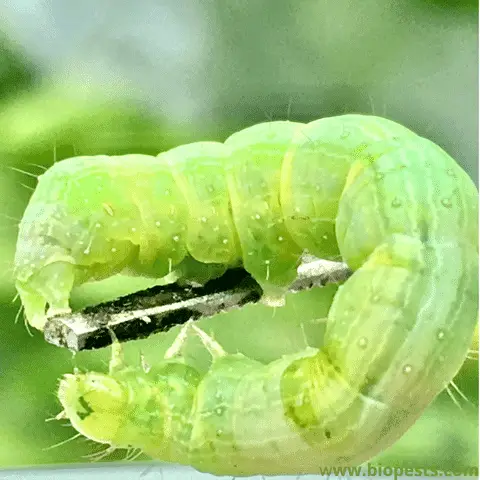
How To Get Rid Of Cabbage Loopers On Radishes?
In the early season of growing radishes, using floating row covers to prevent moths from laying their eggs on your radishes is a good idea. Check your crops regularly by thoroughly inspecting the leaves top and bottom. Remove any eggs and pick off caterpillars by hand.
If you keep chickens, you can feed them worms. Or you could drown them in soapy water and discard them. Food-grade diatomaceous earth can be effective if the infestation is small. Sprinkle around the top and bottom of the leaves. Repeat after it has rained. Available on Amazon at this link.
Use Predators To Destroy Cabbage Loopers on Radishes
Cabbage loopers have natural enemies, such as parasitic wasps that lay their own eggs inside the loopers. This halts their development. You can release parasitic wasps into the garden when you see the adult moths or the eggs.
The green lacewing larvae are another predator that feeds on the cabbage looper eggs. You can also find a supply of lacewing eggs to place onto the radish plant. These eggs will hatch within 3 days and eat the looper eggs.
Biologically Control Cabbage Loopers On Radishes
You could also use Bacillus Thuringiensis (Btk), a soil bacterium. When the cabbage loopers ingest the bacterium, it releases a toxin that paralyzes their digestive system. This soil bacterium is not harmful to humans, birds, pets, fish, or beneficial insects.
The best time to use Btk is shortly after the cabbage loopers have hatched. Spray the entire radish plant, ensuring the top and bottom leaves are also covered with the bacterium.
Organic Insecticides Will Control Cabbage Loopers On Radishes
Although organic insecticides (pyrethrin-based) will kill the larvae and eggs on contact, they should be used cautiously. This insecticide will also kill beneficial insects such as honeybees and other pollinators.
Chemical Pesticides To Rid Cabbage Loopers On Radishes
Chemical pesticides must be used as the last method to eliminate cabbage loopers. This method will very likely also kill all beneficial insects from your garden. You could use carbaryl or cyfluthrin. Follow the manufacturer’s instructions to safely apply the chemicals.
Wireworms Attack Radish
Wireworms are thin and shiny, yellow-to-reddish-brown-colored worms and are the larvae of several species of click beetles. They grow to a length of ¼ to 1 ½ inches and are approximately 1/8th of an inch wide.
The adult click beetle are brown or black beetles. Should they become overturned, these beetles make a clicking sound when they try to right themselves. The adults do not cause harm, but the larvae eat seeds and seedlings. They will also eat the underground roots and stems of older plants.
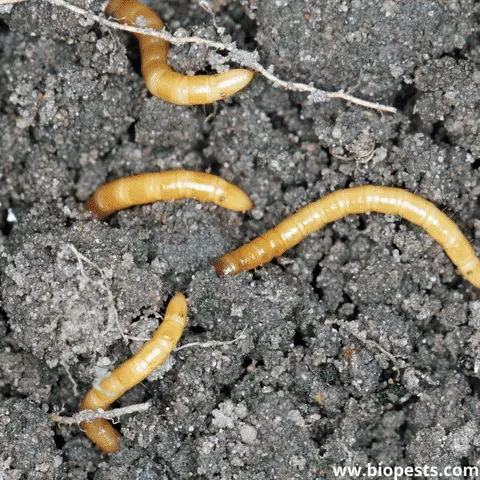
How To Get Rid Of Wireworms?
If you have wireworms feeding on your radishes, you cannot eliminate them efficiently by using insecticides. The best method is to bait them and remove them by hand. But this will only work if the infestation is small.
- Dig trenches 2 to 4 inches deep and at least 3 feet apart.
- Fill the trenches with germinating corn, beans, or peas. Cover with a board.
- The wireworms will be attracted to the seeds and will gather in the trench to feed.
- Remove the board after a week. If there are worms, destroy the worms by crushing them.
Another tip is to thread thickly sliced potato pieces through a long stick. Place the stick in the soil between the radishes. Leave it there throughout the season. Every week, pull up the stick, remove the damaged slices, and replace them with new potato slices if required. The wireworms will feed on the potatoes and not the roots of your radishes.
Outbreaks of wireworms are rare. But if you have an ongoing problem with these worms, you can add insecticides into the soil before planting. However, treating insecticides once the wireworms are already present will have no effect.
Radishes Are Eaten By Cabbage Maggots
Cabbage maggots are horrible pests that tunnel their way through the roots of the radish. They are transmitters of a bacterial black soft spot, a rot disease. Cabbage maggots are the larvae of the cabbage maggot fly.
The larvae are white or cream colored and are only ¼ inch in size. They do the most damage to seedlings but stunt growth in mature plants and cause the leaves to taste bitter. Seedlings and mature plants affected by cabbage maggots will have a blueish color to their leaves.
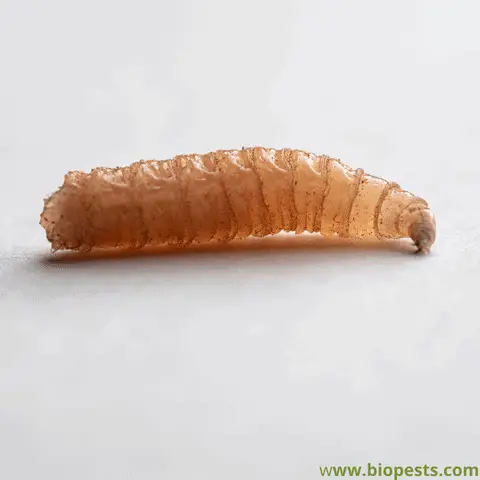
How To Treat The Soil After a Cabbage Maggot Problem?
It is best to plant your radishes in another location where you have had problems with cabbage maggots. Here is how to treat and prepare the damaged soil in the fall:
- Add a layer (1 to 2 inches) of well-aged compost to the soil.
- Mix the compost thoroughly into the soil.
- In the spring, plant the seeds. When the seedlings emerge, add a dusting of lime or wood ashes around them. This is to keep away adult flies who will be attracted to the freshly tilled soil.
- Keeping weeds and other organic debris out of this area is essential.
Other Methods Used To Keep Worms Away From Radishes
Below are a few other methods gardeners use to prevent worms from destroying their radishes.
- Plant garlic – in winter, plant garlic in your radish garden. Plant them 4 to 6 weeks before the last expected frost. Plant the garlic in spaces 4 to 6 inches apart and in rows spaced 2 feet apart. In 2 to 3 weeks, sow the radish seeds in the rows between the garlic.
- Plant herbs – plant rosemary, mint, and sage in your radish garden to avoid cabbage maggots and other worms. Plant the herbs in 10-inch-deep plastic pots with the bottoms cut out before you plant them in the garden. This will curb the herbs from spreading and taking over the garden. The best time to grow herbs is late winter to early spring.
- Plant marigolds – these flowers will repel cabbage maggots. Sow the marigold seeds directly into the radish garden in spring. Space the seeds according to the variety of marigold and their size. Some can grow to only 6 to 12 inches, and others to 3 feet tall.
Conclusion
Although radishes are speedy growers and have few pests, worms can cause damage to their roots and leaves. Cutworms, cabbage loopers, wireworms, and cabbage maggots are worms that attack the radish plant. There are methods to remove these pests from the radishes without using chemical pesticides that harm other beneficial insects.
Making sure the soil has good drainage, planting seeds when the soil is warm, controlling weeds, and spreading alkaline mulch around the plants, are good ways to control worm pests. To control pests, you could also plant garlic, marigolds, and herbs like rosemary and mint in your radish garden.
If you are a radishes lover, check out these articles!
Which Radishes Are The Spiciest? What Makes Them Spicy
Radish Vs. Horseradish. What’s The Difference?
Why Do Radishes Taste Like Soil? Here Is Why
Some of the links above are affiliate links, meaning, at no additional cost to you, I will earn a commission if you click through and make a purchase.

